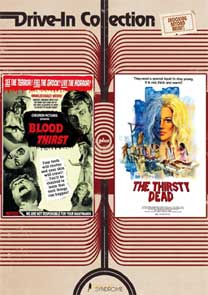 DRIVE-IN
COLLECTION: BLOOD THIRST (1971)/THE
THIRSTY DEAD (1974)
DRIVE-IN
COLLECTION: BLOOD THIRST (1971)/THE
THIRSTY DEAD (1974)Director(s): Newt Arnold/Terry Becker
Vinegar Syndrome
 DRIVE-IN
COLLECTION: BLOOD THIRST (1971)/THE
THIRSTY DEAD (1974)
DRIVE-IN
COLLECTION: BLOOD THIRST (1971)/THE
THIRSTY DEAD (1974)Filipino exploitation films with Vic Diaz but not directed by Cirio H. Santiago are actually not a rare thing at all, and Vinegar Syndrome has combined two of them for their latest Drive-in Collection release: Newt Arnold’s BLOOD THIRST and Terry Becker’s THE THIRSTY DEAD.
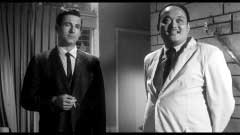
In BLOOD THIRST, the seventh in a series of murders of beautiful women drained of their blood prompts local detective Miguel Cruz (Vic Diaz, FIRECRACKER) to consult New York-based Adam Rourke (Robert Winston, THE STARFIGHTERS) – a writer on sex crimes and their motivations – to Manila to consult on the case. Rourke decides to go undercover as a tourist at the nightclub where the last victim worked. He approaches the manager Calderon (Vic Silayan, NIGHT OF THE COBRA WOMAN) under the guise of a journalist interested in doing a “human interest” story on the victim. Calderon promises to think it over, and Rourke seemingly gets an answer in the form of an assassination attempt in his hotel room. When the next two victims turn out to also be employees of the nightclub, Rourke is certain that Calderon and the club’s mysterious lead entertainer Serena (Yvonne Nielson) are somehow involved. The case becomes personal, however, when Miguel’s adopted sister Sylvia (Katherine Henryk) takes it upon herself to go undercover as a waitress at the club.
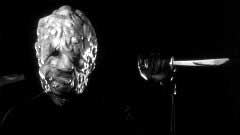 Shot
in 1965 in black-and-white but not released stateside until 1971 by Chevron
Pictures (on a double bill with Robert Harford Davis’ INCENSE FOR THE
DAMNED under the title BLOODSUCKERS), BLOOD THIRST is mostly a snooze despite
an interesting monster (well, two interesting monsters of a sort) and some surprising
bloodshed for 1965. Suave-looking Winston is more of a presence than a performer,
which becomes all the more apparent during the many scenes where he is thinking
aloud puzzling over the case or Sylvia’s behavior. Diaz appears to be
dubbed by someone affecting a slight accent and trying to match his slow line
delivery, but Henryk is a nice surprise running hot and cold as Rourke’s
love interest. The film’s best aspects are ultimately Nielson and the
mostly gorgeous monochrome cinematography of Hermos Santos, which come together
nicely during her main dance set-piece. Despite the blood cult and Philippines
location connection, BLOOD THIRST would probably have been better paired with
Ákos Ráthonyi’s West German/Yugoslavian CAVE OF THE LIVING
DEAD (released stateside by Richard Gordon) or Del Tenney’s I EAT YOUR
SKIN. Indeed, BLOOD THIRST was previously released by DVD by Retromedia in a
triple bill with the longer cut of the Tenney Film (originally titled ZOMBIE)
and BLOOD STALKERS, and before that by Something Weird Video/Image Entertainment
on a double bill with Robert Harford Davis’ BLOODSUCKERS (the film’s
original 1971 Chevron Pictures co-feature). I have not seen either of those
versions, but Vinegar Syndrome’s progressive, anamorphic widescreen (1.85:1)
transfer is mastered in 2K from a fairly clean 35mm print source with occasional
scratches and reel change marks that milks the transfer for all its worth, revealing
a high contrast glossy noir look in the club scenes and night street scenes,
while other on-the-fly shots at least look a little flat but their at least
well-exposed. The Dolby Digital 2.0 mono track is variably hissy and scratchy,
but that doesn’t interfere with the dialogue or music.
Shot
in 1965 in black-and-white but not released stateside until 1971 by Chevron
Pictures (on a double bill with Robert Harford Davis’ INCENSE FOR THE
DAMNED under the title BLOODSUCKERS), BLOOD THIRST is mostly a snooze despite
an interesting monster (well, two interesting monsters of a sort) and some surprising
bloodshed for 1965. Suave-looking Winston is more of a presence than a performer,
which becomes all the more apparent during the many scenes where he is thinking
aloud puzzling over the case or Sylvia’s behavior. Diaz appears to be
dubbed by someone affecting a slight accent and trying to match his slow line
delivery, but Henryk is a nice surprise running hot and cold as Rourke’s
love interest. The film’s best aspects are ultimately Nielson and the
mostly gorgeous monochrome cinematography of Hermos Santos, which come together
nicely during her main dance set-piece. Despite the blood cult and Philippines
location connection, BLOOD THIRST would probably have been better paired with
Ákos Ráthonyi’s West German/Yugoslavian CAVE OF THE LIVING
DEAD (released stateside by Richard Gordon) or Del Tenney’s I EAT YOUR
SKIN. Indeed, BLOOD THIRST was previously released by DVD by Retromedia in a
triple bill with the longer cut of the Tenney Film (originally titled ZOMBIE)
and BLOOD STALKERS, and before that by Something Weird Video/Image Entertainment
on a double bill with Robert Harford Davis’ BLOODSUCKERS (the film’s
original 1971 Chevron Pictures co-feature). I have not seen either of those
versions, but Vinegar Syndrome’s progressive, anamorphic widescreen (1.85:1)
transfer is mastered in 2K from a fairly clean 35mm print source with occasional
scratches and reel change marks that milks the transfer for all its worth, revealing
a high contrast glossy noir look in the club scenes and night street scenes,
while other on-the-fly shots at least look a little flat but their at least
well-exposed. The Dolby Digital 2.0 mono track is variably hissy and scratchy,
but that doesn’t interfere with the dialogue or music.
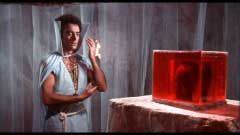
After a series of disappearances of young women attributed by the press to a white slaving ring, the Filipino authorities warn women (well, white women) not to venture out at night unescorted. When Laura (Jennifer Billingsley, C.C. AND COMPANY) is nabbed by a pair hooded figures, she finds herself in good company with local girl Bonnie (Chiqui da Rosa), meek blonde Ann (Fredricka Meyers, PRETTY MAIDS ALL IN A ROW), and dancer Claire (Judith McConnell, THE DOLL SQUAD). Although they are ferried into the jungle to a mountain fortress and into a cell (with beaded curtain gates), Claire isn’t too worried since she considers any job you can do on your back preferable to go-go dancing; that is, until they are readied to be blood sacrifices. Laura is the exception since she resembles the “divine likeness” sketched by high priest Baru (John Considine, CALIFORNIA SPLIT) of the blonde woman who resurrected the cult’s leader Raoul (now an oracle head in a block of red ice dispensing prophecy). The other three women are bled but not killed, and Laura learns that the cult of Raoul sustain their youth by regularly consuming the blood of those lucky enough to be chosen. When she refuses the gift, high priestess Ranu (Tani Guthrie, I, THE JURY) orders Baru to show her what happens to those who refuse, and Laura realizes that seducing Baru may be the only way for her and her cellmates to escape.
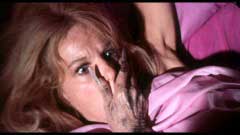 THE
THIRSTY DEAD shares with its co-feature Vic Diaz (in an even smaller role as
a detective) and editor Anthony DiMarco, yet it’s lacking in even BLOOD
THIRST’s meager thrills. While some seventies PG-rated films have their
share of shocking gore and nudity, and THE THIRSTY DEAD has a scenario with
plenty of exploitable elements including high priestesses is sheer outfits and
beauties abducted for ritual sacrifice; but it’s all rather boringly chaste
(McConnell’s go-go dancer is mainly on hand for comic relief). Considine
isn’t particularly charismatic here and was far more entertaining in the
title role of DR. DEATH: SEEKER OF SOULS the year before, while Guthrie was
also used to better effect in the Filipino-lensed movie DAUGTHERS OF SATAN (1972).
Billingsley tries her best, but it’s all in vain, and the film ultimately
deserves the bottom-shelf-of-the-video-store PD/bootleg video and DVD reputation
it has had for years.
THE
THIRSTY DEAD shares with its co-feature Vic Diaz (in an even smaller role as
a detective) and editor Anthony DiMarco, yet it’s lacking in even BLOOD
THIRST’s meager thrills. While some seventies PG-rated films have their
share of shocking gore and nudity, and THE THIRSTY DEAD has a scenario with
plenty of exploitable elements including high priestesses is sheer outfits and
beauties abducted for ritual sacrifice; but it’s all rather boringly chaste
(McConnell’s go-go dancer is mainly on hand for comic relief). Considine
isn’t particularly charismatic here and was far more entertaining in the
title role of DR. DEATH: SEEKER OF SOULS the year before, while Guthrie was
also used to better effect in the Filipino-lensed movie DAUGTHERS OF SATAN (1972).
Billingsley tries her best, but it’s all in vain, and the film ultimately
deserves the bottom-shelf-of-the-video-store PD/bootleg video and DVD reputation
it has had for years.
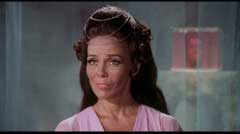 One
of the last theatrical releases of International Amusement Corporation –
the logo of which appears at the head of this presentation – THE THIRSTY
DEAD was released on tape in a clamshell edition by King of Video stateside
(and later by World Video Pictures and Direct Video under the title BLOOD HUNT)
and Interglobal north of the border. It was released by Something Weird Video/Image
Entertainment on a double-bill with Manuel Caño’s Spanish-produced
Florida-lensed SWAMP OF THE RAVENS. Vinegar Syndrome’s progressive, anamorphic
widescreen (1.85:1) must be the film’s classiest presentation (theatrically
or home video), even if it is not perfect. Although mastered in 2K, the 35mm
print source has occasional vertical and horizontal scratches, and the Dolby
Digital 2.0 mono audio is hissy and crackly (but really no more distracting
than the damage to the image). What few saturated colors there are vibrant but
there are actually very few bold colors in the art direction.
(Eric
Cotenas)
One
of the last theatrical releases of International Amusement Corporation –
the logo of which appears at the head of this presentation – THE THIRSTY
DEAD was released on tape in a clamshell edition by King of Video stateside
(and later by World Video Pictures and Direct Video under the title BLOOD HUNT)
and Interglobal north of the border. It was released by Something Weird Video/Image
Entertainment on a double-bill with Manuel Caño’s Spanish-produced
Florida-lensed SWAMP OF THE RAVENS. Vinegar Syndrome’s progressive, anamorphic
widescreen (1.85:1) must be the film’s classiest presentation (theatrically
or home video), even if it is not perfect. Although mastered in 2K, the 35mm
print source has occasional vertical and horizontal scratches, and the Dolby
Digital 2.0 mono audio is hissy and crackly (but really no more distracting
than the damage to the image). What few saturated colors there are vibrant but
there are actually very few bold colors in the art direction.
(Eric
Cotenas)